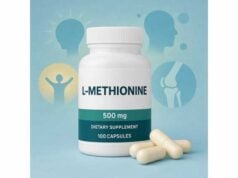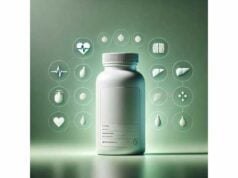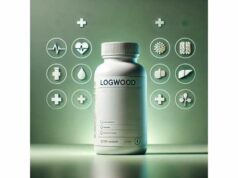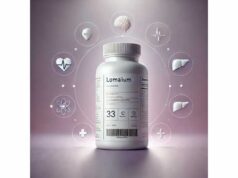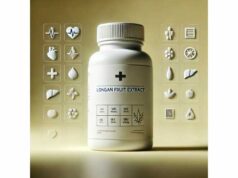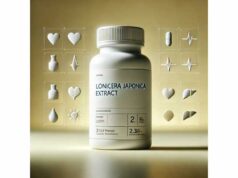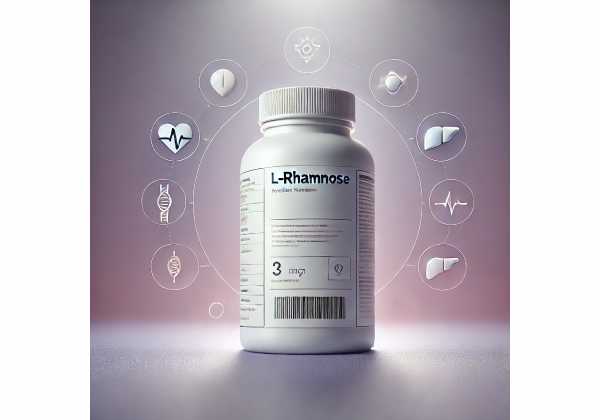
L-rhamnose is a naturally occurring deoxy sugar found in many plants (including citrus peels and buckthorn), in certain bacterial cell walls, and as part of complex molecules called glycosides. Unlike glucose, L-rhamnose is poorly absorbed in the small intestine and typically reaches the colon, where gut microbes ferment it—often producing the short-chain fatty acid propionate. Because of this route, L-rhamnose shows up in three very different contexts: as a prebiotic-like carbohydrate studied for effects on metabolism, as a probe sugar in clinical tests of intestinal permeability, and as a topical ingredient explored in anti-aging skin care. This guide explains what L-rhamnose is, how it is used, what human studies suggest so far, practical ways to try it (if it fits your goals), dosing ranges used in research, and safety points to consider.
Quick Overview
- Fermented by gut microbes; commonly raises serum propionate after 25 g test doses.
- Used clinically with lactulose or mannitol as a noninvasive marker of intestinal permeability.
- Topical formulas (often 5% rhamnose) have early evidence for supporting dermal matrix proteins.
- Oral research doses range from 25 g once to 25 g/day for 4 weeks; high intakes may cause gas.
- Avoid self-experimenting in uncontrolled diabetes, significant GI disease, or if advised to limit fermentable carbs.
Table of Contents
- What is L-rhamnose?
- Benefits and where it helps
- How to use it well (oral and topical)
- Dosage and timing
- Safety, side effects, and who should avoid it
- What the research says (and what it does not)
What is L-rhamnose?
A deoxy sugar with unusual fates. L-rhamnose (6-deoxy-L-mannose) is a six-carbon monosaccharide. Humans do not have a dedicated transporter for L-rhamnose in the small intestine, so most of an oral dose travels onward to the colon. There, specific bacteria ferment it into short-chain fatty acids (SCFAs)—particularly propionate, along with smaller amounts of acetate and butyrate. These SCFAs are absorbed and can influence metabolic signaling in the liver and peripheral tissues.
Why it matters:
- As a probe sugar. Because L-rhamnose is small and relatively minimally absorbed across tight junctions, it is paired with a larger sugar like lactulose in a classic lactulose:rhamnose (L:R) urinary test. The L:R ratio helps clinicians infer intestinal permeability. A higher L:R ratio suggests increased paracellular leak or decreased absorptive surface area.
- As a fermentable carbohydrate. L-rhamnose can selectively raise circulating propionate in humans after a sizable dose. Propionate is involved in gluconeogenesis in the liver and has been investigated for potential effects on lipid metabolism and post-meal insulin secretion.
- As a topical cosmetic ingredient. In skin, rhamnose has been explored for its ability to influence dermal fibroblasts and the dermal-epidermal junction, with early work showing effects on procollagen I and collagen IV expression in vivo and in reconstructed skin models.
Where you encounter it:
- Laboratory/clinic: In permeability testing solutions (with lactulose or mannitol), followed by timed urine collection.
- Nutrition research: As a test sugar given in standardized drinks to study fermentation, SCFA profiles, and metabolic outcomes.
- Over-the-counter skin care: As part of creams or serums (often labeled “rhamnose 5%”), positioned for firmness and wrinkle depth.
Key takeaways: L-rhamnose is not a vitamin or amino acid; it is a functional carbohydrate used for diagnostics, research on gut-microbe metabolism, and select topical formulations. Most everyday diets contain only small amounts. If you use it orally, expect GI fermentation—that is the point—and plan around that reality.
Benefits and where it helps
1) Supports research-grade modulation of colonic propionate.
In controlled human trials, ingesting L-rhamnose acutely (single 25 g dose) raises serum propionate compared with glucose and, in some comparisons, lactulose. Over four weeks at 25 g/day, L-rhamnose continues to bias circulating SCFAs toward propionate. Why would this matter? Propionate is a biologically active SCFA that can:
- Serve as a gluconeogenic substrate in the liver.
- Signal through free fatty acid receptors (FFAR2/FFAR3) on enteroendocrine cells.
- Potentially influence aspects of lipid metabolism when the acetate:propionate balance shifts.
Practically, this means L-rhamnose is a tool compound rather than a mainstream dietary fiber: researchers use it when they specifically want to study propionate-dominant fermentation.
2) May attenuate post-meal insulin secretion in the short term.
In small, crossover studies in healthy adults, meals supplemented with L-rhamnose (≈25 g/day protocol) have shown a lower postprandial insulin response compared with control meals, without consistent effects on subjective appetite ratings or actual energy intake. The presumed mechanism involves colonic propionate signaling rather than changes in carbohydrate absorption in the small intestine.
3) Noninvasive assessment of gut permeability.
The lactulose:rhamnose test is widely used in research and some clinical contexts to estimate small-intestinal permeability. After ingesting a fixed L-rhamnose plus lactulose solution, the urinary L:R excretion ratio over a set interval acts as a surrogate for tight-junction status (paracellular flux) and mucosal absorptive area. This is not a supplement benefit per se, but it is a core “use case” for L-rhamnose in medicine and nutrition science.
4) Skin appearance and dermal support (topical use).
Topical products containing rhamnose 5% have been examined in laboratory and clinical settings. In vivo measurements and reconstructed-skin models show increased procollagen I and collagen IV, with signals at the dermal-epidermal junction (an area that thins with age). Early clinical work reports improvements in parameters related to firmness and wrinkle depth over weeks of regular use. These studies are promising but not definitive; they support using rhamnose as one element within a broader skin-care program (sun protection, retinoids as tolerated, moisturization).
5) Microbiome-friendly carbohydrate option for experiments.
Compared with classic prebiotics like inulin, L-rhamnose appears to produce less breath hydrogen in some settings, though gas and bloating can still occur—especially in the first week. For people who want to experiment with SCFA-centric nutrition science under professional guidance, L-rhamnose can be one way to nudge the acetate:propionate balance without adding large amounts of viscous fibers.
Realistic expectations:
- Metabolism: Any insulin or lipid-metabolism effects in small trials are modest and research-oriented, not therapeutically proven.
- Skin: Topical results accrue over 8–12 weeks and remain incremental.
- Gut: Gas and bloating are common early; they usually lessen as the microbiota adapt.
How to use it well (oral and topical)
Clarify your purpose first. L-rhamnose is unusual because it lives in three worlds—diagnostics, nutrition research, and cosmetics. Your approach should match your goal:
A) If your goal is laboratory-grade gut insights
- Work through a clinician or research lab for the lactulose:rhamnose test. They will supply a standardized solution, timing instructions, and a collection kit. Do not attempt to replicate the protocol at home; the results depend on precise timing, volumes, and analytical methods.
B) If your goal is to explore SCFA-focused nutrition
- Recognize that human trials typically use high, standardized loads (e.g., 25 g per test day or per day for several weeks) blended into a meal or beverage. That is far more than you would get in a normal diet.
- A pragmatic, stepwise approach—if you and your clinician agree to try it—could look like this:
- Ensure basic dietary fiber is in order (vegetables, pulses, whole grains, resistant starch where tolerated).
- Introduce small amounts of L-rhamnose (for example 5 g with a meal, powder blended in yogurt or a shake) to gauge tolerance.
- If you have a specific experimental endpoint (e.g., blood lipids while weight-stable), your clinician may titrate toward research-like intakes (up to 25 g/day), monitor GI comfort, and track labs.
- Keep a symptom and meal log for two weeks; note gas, bloating, bowel habits, and any changes in appetite or energy.
C) If your goal is skin support
- Choose a topical product where rhamnose concentration is disclosed (commonly 5%).
- Apply once or twice daily on cleansed skin. Pair with:
- AM: broad-spectrum sunscreen.
- PM: a retinoid (if tolerated) and a barrier-supporting moisturizer.
- Expect subtle changes in firmness and texture after 8–12 weeks; continue core skin health habits regardless.
Practical tips for oral use:
- Taste and mixing: L-rhamnose is mildly sweet and dissolves well in water, smoothies, or yogurt.
- GI tolerance: Gas and bloating are common early; splitting doses with meals helps.
- Stacking: L-rhamnose is not a substitute for dietary fiber diversity. Think of it as a targeted fermentable layered onto a fiber-adequate diet, not a standalone fix.
Dosage and timing
Important context: There is no established dietary requirement or consumer “recommended” dose for L-rhamnose. The best dose depends on why you are using it.
For gut permeability testing (clinical/research):
- Labs typically provide a pre-measured solution containing lactulose plus L-rhamnose in specific ratios (e.g., 5 g lactulose + 0.5 g L-rhamnose, or similar). You drink the solution once, then collect urine for a defined period. Follow the lab protocol exactly; do not self-dose.
For SCFA/propionate-focused experiments (under professional supervision):
- Acute test day: 25 g once with a meal or beverage.
- Short trials: 25 g/day for 4 weeks (often split with meals).
- Everyday exploration: If you and your clinician decide to try a gentler approach, consider 5–10 g with a meal, watch tolerance for 1–2 weeks, and only increase if well tolerated and if there is a clear plan to assess outcomes.
For topical skin use:
- Products often use 5% rhamnose, applied once or twice daily. Pair with sun protection and barrier care for best results.
Timing considerations (oral):
- Take with meals to improve tolerance.
- If you monitor post-meal glucose or insulin curves in a supervised setting, align dosing with the test meals used in your protocol.
- Expect GI adaptation over 7–10 days at higher intakes; symptoms often ease with time.
Who should start low:
- People with a history of IBS, SIBO, or sensitivity to fermentable carbs should begin at 5 g or less and advance slowly—if at all—based on guidance.
What not to do:
- Do not treat L-rhamnose as a general “fiber supplement” at 25 g/day without a defined reason and professional oversight. Typical dietary fiber targets are better met by whole foods and established prebiotics.
Safety, side effects, and who should avoid it
Overall tolerance:
- In controlled studies, L-rhamnose up to 25 g/day for 4 weeks was generally well tolerated. The most frequent complaints are gas and bloating, especially during the first week. These effects are similar to other fermentable carbohydrates and often diminish as the microbiota adapt.
Potential side effects:
- GI: Gas, bloating, abdominal cramping, and changes in stool pattern (usually mild). Splitting doses and taking with meals can help.
- Rare: Loose stools at higher intakes; usually resolves with dose reduction.
Cautions and special situations:
- Diabetes and glucose management: While small trials suggest a lower postprandial insulin response with L-rhamnose-supplemented meals, this has not been shown to improve clinical outcomes. If you monitor glucose or use insulin/sulfonylureas, do not adjust medications based on rhamnose use without medical supervision.
- Significant GI disease: In IBD flares, short-gut, active SIBO, or post-surgical states, avoid new fermentable carbohydrates unless your gastroenterology team approves.
- Food intolerance patterns: If you strongly react to FODMAPs, proceed carefully or avoid.
- Pregnancy/lactation and pediatrics: There is insufficient evidence to recommend oral L-rhamnose beyond normal dietary exposure. Use only if a clinician directs (e.g., for a permeability test).
- Allergies: L-rhamnose is a sugar, not a protein; true allergy is unlikely. However, commercial powders can contain trace contaminants—choose reputable suppliers.
Medication interactions:
- No specific pharmacokinetic interactions are well established. The main consideration is GI fermentation potentially altering comfort or meal timing around medications. Space new supplements at least 2 hours away from critical drugs when possible and confirm with your pharmacist.
Quality notes (oral and topical):
- Oral powders: Look for identity testing, purity data, and contaminants screening (microbial counts, heavy metals).
- Topicals: Seek products disclosing rhamnose concentration and showing compatible partners (e.g., vitamin C derivatives, peptides) without over-irritating actives stacked together.
When to stop and seek care:
- Persistent or severe abdominal pain, unintended weight loss, fever, GI bleeding, or any sign of dehydration warrants medical evaluation—whether or not rhamnose is involved.
What the research says (and what it does not)
What is well supported in humans:
- Propionate bias: Single 25 g L-rhamnose doses increase serum propionate compared to glucose, and 4 weeks of 25 g/day maintains this effect. Compared with lactulose, L-rhamnose tends to favor a lower acetate:propionate ratio, consistent with selective microbial fermentation pathways.
- GI side effects are expected but manageable: Gas and bloating are common, with less breath hydrogen in some comparisons than with inulin or lactulose, and symptoms often attenuate after the first week.
- Post-meal insulin: In a randomized crossover setting, meals with L-rhamnose reduced postprandial insulin versus control without affecting subjective appetite or ad libitum intake. This points to metabolic signaling (likely SCFA-mediated), not reduced caloric absorption.
What is promising but needs more data:
- Topical skin benefits: In vitro/reconstructed skin and in vivo human assessments show increases in procollagen I and collagen IV and signals at the dermal-epidermal junction, with associated improvements in firmness parameters. These results support trying rhamnose in a modern routine, but large, independent trials are limited.
- Cardiometabolic outcomes: Shifting acetate:propionate balance is mechanistically interesting for lipid metabolism, but hard outcomes (LDL-C changes, hepatic fat, glycemic durability) have not been established with L-rhamnose outside small, short studies.
What it does not do:
- L-rhamnose is not a cure or primary therapy for diabetes, dyslipidemia, or obesity.
- It does not replace comprehensive dietary fiber strategies or evidence-based skin treatments (photoprotection, retinoids, procedures as appropriate).
How to interpret the field right now:
- Consider L-rhamnose a precision fermentable used by researchers to probe propionate-dominant microbial metabolism and a topical adjunct with early supportive data. The most actionable consumer applications are topical products and clinician-directed testing of gut permeability. Oral self-experimentation above 5–10 g/day should be purposeful, time-limited, and supervised.
References
- L-Rhamnose increases serum propionate in humans 2004 (Clinical Trial)
- L-Rhamnose increases serum propionate after long-term supplementation, but lactulose does not raise serum acetate 2004 (Clinical Trial)
- L-rhamnose as a source of colonic propionate inhibits insulin secretion but does not influence measures of appetite or food intake 2016 (RCT)
- The sensitivity of the lactulose/rhamnose gut permeability test 1999 (Comparative Study)
- Potentially beneficial effects of rhamnose on skin ageing 2019 (In vitro and In vivo Study)
Disclaimer
This article is educational and does not replace personalized medical advice. Do not use L-rhamnose to diagnose or treat any condition without guidance from a qualified clinician. If you have diabetes, significant gastrointestinal disease, or are pregnant or breastfeeding, consult your healthcare professional before using any new oral supplement or undergoing permeability testing. Stop use and seek care if you experience concerning symptoms.
If you found this helpful, please consider sharing it on Facebook, X (formerly Twitter), or any platform you prefer, and follow us for future evidence-based guides. Your support helps us keep creating high-quality content.

